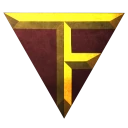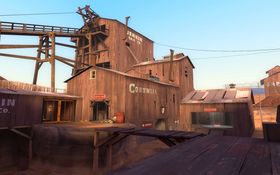




Released in 1996 as a mod for QuakeWorld, Team Fortress (TF) didn't just change how Quake was played—it revolutionized multiplayer gaming itself. At its peak between 1997 and 1999, QWTF had an estimated 40,000 active players worldwide, making it one of the first major competitive team-based FPS games. It spawned hundreds of clans and leagues globally, laying the groundwork for modern esports and class-based shooters that continue to dominate the industry today.
Before Team Fortress, the world of multiplayer first-person shooters (FPS) was primarily centered around deathmatch (DM) and free-for-all (FFA) combat. Games like:
- Doom (1993) – The first mainstream multiplayer FPS, but limited to simple "kill or be killed" gameplay.
- Quake (1996) – Introduced true online multiplayer with TCP/IP support, and more fluid movement, but still focused on arena-based fragging.
- Duke Nukem 3D (1996) – Added some interactive environments, but its multiplayer was mostly an extension of single-player combat.
PnP formed on the south east coast of Australia in 1997, during a time when going online daily was still considered unusual. Operating on 28k or 33k modems while many clans were establishing themselves from University connections with low pings, PnP faced significant technical disadvantages. Despite this, through determination and keen talent scouting, PnP rose from humble beginnings to become a powerhouse in the competitive scene.
Instead of following the deathmatch formula, Team Fortress introduced class-based, team-oriented gameplay, creating an entirely new subgenre of shooters.
Class-Based Gameplay: The First of Its Kind
Before TF, everyone in an FPS played the same way—you ran around collecting weapons and armor, and the best aim usually won. Team Fortress introduced unique player classes, each with distinct abilities, weapons, and roles.
The original nine TF classes were:
- Scout – Fast but weak, ideal for capturing objectives.
- Sniper – Long-range specialist with headshot potential.
- Soldier – Heavy firepower with a rocket launcher, good for defense and offense.
- Demoman – Expert in explosives, capable of setting traps.
- Medic – Healed teammates and was the backbone of team support.
- Heavy Weapons Guy – Slow but carried a devastating minigun.
- Pyro – Short-range flame-based attacks to clear out areas.
- Spy – Could disguise and backstab enemies, pioneering stealth mechanics in FPS.
- Engineer – Could build sentry guns, ammo dispensers, and teleporters, adding a strategic layer.
Team Fortress started as a Quake mod but its influence can be found in every major multiplayer FPS game today, including:
- Counter-Strike (1999)
- Battlefield (2002)
- Call of Duty (2003)
- Overwatch (2016)
- Valorant (2020)
One of the most unique and innovative aspects of QuakeWorld Team Fortress (QWTF) was the introduction of weapon combination skills. Unlike most first-person shooters of the time, which restricted players to using only one weapon at a time, TF players could chain multiple weapons together seamlessly. This elevated combat from simple shooting mechanics into a highly skill-based discipline requiring precise execution and deep knowledge of the game's mechanics.
Primary, Secondary, and Tactical Grenades: The Multi-Layered Arsenal
Each class had access to a primary weapon, a secondary weapon, and grenades, allowing players to chain attacks in rapid succession.
For example:
- Soldiers could rocket launch at an enemy while simultaneously throwing a nail grenade to add additional explosive damage.
- Demomen could fire a pipe bomb, switch to their grenade launcher, and detonate stickies in mid-air for advanced area denial.
- Spies could throw a gas grenade to weaken enemies, then swiftly switch to their knife for an instant backstab.
- Medics, known for their aggressive playstyle, could use super nailgun shots while throwing a concussion grenade to disorient and dodge at the same time.
Another groundbreaking innovation in TF was its movement mechanics, which took advantage of Quake's physics engine to create high-speed, momentum-based traversal techniques. These skills weren't just exploits or gimmicks—they became integral to high-level play.
Rocket Jumping: The Soldier's Essential Skill
By aiming a rocket at the ground and jumping at the same time, Soldiers could launch themselves into the air. Skilled players could cross entire maps in seconds, reach high-ground advantage points, or dodge incoming fire. Rocket jumping turned the Soldier from a slow-moving tank into a mobile shock trooper.
Grenade Jumping: Advanced Mobility for Multiple Classes
Unlike rocket jumping, grenade jumps required precise timing and planning. Players could drop a grenade, wait for the fuse timer, and jump at the perfect moment to blast themselves across the map. Scouts and Medics used concussion grenades to perform "conc jumps", allowing for mid-air direction changes and insane speeds.
Combination Jumps: Master-Level Techniques
The best TF players didn't just use a single jump method—they chained techniques together to perform insane aerial maneuvers:
- A rocket jump followed by a grenade jump could launch a player across the map in a single move.
- Mid-air strafing during conc grenade jumps allowed for directional air control, making it harder to be shot down.
- Engineers even used Sentry knockback tricks to perform their own jumps!
When Team Fortress 2 (TF2) was released in 2007, it redefined the franchise with a new, casual-friendly direction. While still an incredible game, many of the advanced techniques that made QWTF a skill-based masterpiece were removed or heavily nerfed.
What Changed in TF2
- Grenade jumps were entirely removed, eliminating many of the movement-based mechanics that defined QWTF.
- Concussion grenades, nail grenades, and EMP grenades were removed, simplifying class abilities.
- Weapon combos were reduced, as players were forced into pre-set weapon slots with fewer interactions.
- Rocket jumping was preserved, but its utility was toned down to prevent abuse.
The impact of QuakeWorld Team Fortress (QWTF) extends far beyond its original release in 1996. It redefined what an FPS could be, proving that shooters weren't just about reflexes and twitch aim but could also be about teamwork, strategy, and class diversity. This revolutionized multiplayer gaming, setting the foundation for every major competitive shooter that followed.
While Fortnite may be the most popular game today, many of its core mechanics—class-based roles, team-based objectives, and movement-based combat—owe a great deal to QuakeWorld Team Fortress. The concept of players selecting specific roles with unique abilities, using mobility tricks to gain an advantage, and coordinating in fast-paced, objective-based matches was all pioneered by TF decades earlier. Even Fortnite's build mechanics, which allow players to create cover and navigate terrain dynamically, echo the fast movement, rocket jumps, and grenade jumps that QWTF players mastered long before the battle royale genre even existed.
QWTF didn't just create a new genre—it pioneered a global competitive gaming culture. Before Team Fortress, FPS multiplayer was fast, chaotic, and individualistic. After TF, it became team-based, strategic, and deeply immersive.
Nearly every modern competitive shooter owes something to the mechanics pioneered by TF:
- Counter-Strike (1999) – Adopted team-based objectives, weapon economy, and class-like roles
- Battlefield series (2002) – Used large-scale, class-based combat with vehicles
- Overwatch (2016) & Valorant (2020) – Built upon TF's class-based hero system, teamplay emphasis, and objective control
The influence of TF can be seen in nearly every modern competitive multiplayer game, proving that its groundbreaking ideas are still shaping the gaming industry today. While TF2 may have simplified its mechanics, the hardcore gameplay of the original QWTF is still alive today—through FortressOne.
Today, QWTF lives on through FortressOne, a modern, refined version of the original Team Fortress mod for QuakeWorld. It brings the same fast-paced, class-based gameplay that made TF legendary while refining it with updated graphics, mechanics, and improved netcode—all in an easy-to-install package.
Whether you're a veteran of the old TF leagues or new to classic team-based shooters, FortressOne lets you experience where it all began. No need for the original Quake install—just download, jump in, and play.
Ready to experience the game that shaped FPS history?
 Play FortressOne Now
Play FortressOne Now
 28
28
 11
11
| [PnP]ABC |
|
||||
| [PnP]Ace |
|
||||
| [PnP]Adix |
|
|
|
|
|
| [PnP]Arc |
|
||||
| [PnP]Asmo |
|
||||
| [PnP]Azrael |
|
||||
| [PnP]BabyXeon |
|
||||
| [PnP]Bangers |
|
|
|||
| [PnP]Bern |
|
||||
| [PnP]Berserker |
|
||||
| [PnP]Big D |
|
||||
| [PnP]bliP |
|
|
|
||
| [PnP]Buckwheat |
|
||||
| [PnP]Buttslut |
|
||||
| [PnP]Cann |
|
||||
| [PnP]Chino |
|
|
|
|
|
| [PnP]Coolmody |
|
||||
| [PnP]Covert |
|
||||
| [PnP]Cyberdemon |
|
||||
| [PnP]DigitalJedi |
|
||||
| [PnP]Donaldo |
|
|
|
||
| [PnP]EMHAITCH |
|
|
|
||
| [PnP]eWAt |
|
|
|||
| [PnP]Excess |
|
|
|||
| [PnP]Fat Boy |
|
|
|
|
|
| [PnP]Fluffle Bunny |
|
||||
| [PnP]Fruit |
|
||||
| [PnP]Fuzzy |
|
||||
| [PnP]Gak Man |
|
|
|
|
|
| [PnP]Gascar |
|
||||
| [PnP]GiJoe |
|
||||
| [PnP]Goten |
|
||||
| [PnP]Grim Reaper |
|
||||
| [PnP]Haggas |
|
||||
| [PnP]Haze |
|
||||
| [PnP]Helmet |
|
|
|
|
|
| [PnP]hj |
|
||||
| [PnP]Ishy |
|
||||
| [PnP]Jimmy |
|
||||
| [PnP]jin |
|
|
|
||
| [PnP]Kariya |
|
||||
| [PnP]Kinnear |
|
||||
| [PnP]Kizmet |
|
||||
| [PnP]Kodiak |
|
|
|
||
| [PnP]Kriso |
|
||||
| [PnP]Leviath |
|
|
|
|
|
| [PnP]MaC |
|
||||
| [PnP]MadMike |
|
|
|
|
|
| [PnP]Mailman |
|
||||
| [PnP]marks |
|
||||
| [PnP]Marsh |
|
|
|||
| [PnP]Meks |
|
||||
| [PnP]Messiah |
|
|
|
|
|
| [PnP]Minbari |
|
|
|
|
|
| [PnP]Mr Poo |
|
|
|||
| [PnP]Nem |
|
||||
| [PnP]Nevermind |
|
||||
| [PnP]Novate |
|
||||
| [PnP]oops |
|
|
|||
| [PnP]Pandan |
|
||||
| [PnP]PhantomLord |
|
||||
| [PnP]Phatmike |
|
|
|||
| [PnP]Punker |
|
||||
| [PnP]Raptor |
|
||||
| [PnP]Raver |
|
|
|
|
|
| [PnP]Reactor |
|
||||
| [PnP]rec |
|
||||
| [PnP]Renwald |
|
||||
| [PnP]Rocco |
|
||||
| [PnP]Sandz |
|
|
|||
| [PnP]Scarecrow |
|
||||
| [PnP]Schuey |
|
||||
| [PnP]Seano |
|
||||
| [PnP]Shadow |
|
||||
| [PnP]shenkz |
|
||||
| [PnP]Shivan |
|
|
|||
| [PnP]SilverFox |
|
||||
| [PnP]Sinister |
|
||||
| [PnP]Slappa |
|
|
|
|
|
| [PnP]SLA_YER |
|
||||
| [PnP]Sold |
|
|
|
||
| [PnP]Souless |
|
||||
| [PnP]Teddy |
|
||||
| [PnP]The Governor |
|
||||
| [PnP]Tigs |
|
||||
| [PnP]tod |
|
||||
| [PnP]Tom |
|
||||
| [PnP]Tommyboy |
|
||||
| [PnP]Toules |
|
||||
| [PnP]Trashpak |
|
||||
| [PnP]twisted |
|
||||
| [PnP]Valtiel |
|
||||
| [PnP]Venture |
|
||||
| [PnP]Venus |
|
||||
| [PnP]Vinnie |
|
||||
| [PnP]Vlad |
|
|
|||
| [PnP]Xzi |
|
|
|
||
| [PnP]Zinya |
|
||||
| [PnP]Zoom |
|
|
|
|
|
| [PnP]zut |
|
|

